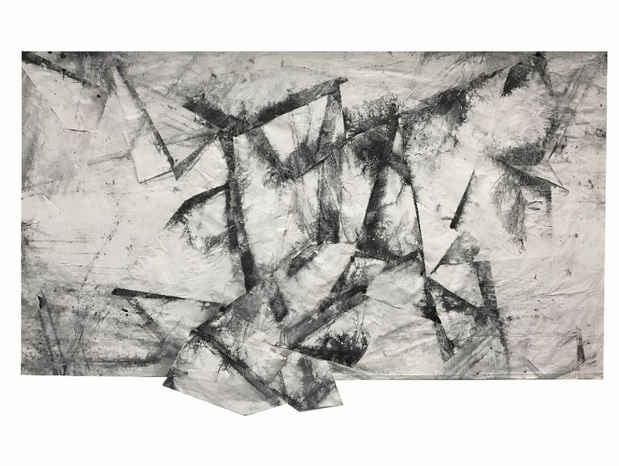“China Now: New Literati Art” Exhibition
Art100

This event has ended.
INK Studio, the critically-acclaimed Beijing-based art gallery, is pleased to announce China Now: New Literati Art, its inaugural group exhibition in North America. On display at ART100 New York during Asia Week, the show will feature compelling new works by some of the most influential Chinese artists working today stretching our understanding of the ink medium: Bingyi, Li Huasheng, Li Jin, Yang Jiechang, and Zheng Chongbin. These artists bring the pre-modern philosophy of the Chinese literati— which sees humankind as a microcosm of a universe in flux and emphasizes cultivation of one’s humanity through practice of the arts — into global contemporary artistic practices. Though their artworks are formally distinctive, these artists all explore literati concepts such as the cultivation and sharing of one’s embodied consciousness (the Chinese “xin”, or “heart-mind”), energetic resonance with the natural world, and the mutually creative relationship between the individual and culture.
After a decade of reclusion and travel through the Himalayas, Li Huasheng (b. 1944) developed the unprecedented practice of limning vast grids in a state of deep meditation. Applied with a pliant brush, each line renders with utmost sensitivity the momentary changes in the state of his body and mind. Li’s grids recall Agnes Martin’s work, which was itself partially inspired by Buddhist philosophy. However, whereas Martin pursued a transcendent mental space—a distinctly Judeo-Christian notion—Li’s grids are grounded in the body and its related cultivation practices such as meditation and calligraphy. Although his works are in the collection of the Metropolitan Museum of Art, and were exhibited there in 2014, this show marks his New York gallery debut.
In his iconic Hundred Layers of Ink series, which debuted in the landmark exhibition Magiciens de la Terre (1989) at the Centre Pompidou, Yang Jiechang (b. 1956) combines ink with durational performance, superimposing layers of ink on the same pieces of paper over weeks. The resultant black surfaces gain a surprising luminescence and sculptural presence, reflecting the notion of awakening through the mindful repetition of mundane actions.
Bingyi’s (b. 1975) experimental practice encompasses land and environmental art, site-specific architectural installation, musical and literary composition, ink painting, performance art and most recently film. This March, her monumental land work Wanwu: Metamorphosis will be featured in the public art Encounters sector of Art Basel | Hong Kong. Bingyi is sometimes compared to site-specific land artists such as Robert Smithson and Walter de Maria. Whereas the human subject, whether as social agent or as artistic creator, remains central in Smithson, Bingyi maintains a perspective common to both Daoism and Buddhism that both absents her individual self and denies the human world as the ultimate ground of meaning. Embracing the natural world’s capacity to speak to us on its own terms, Bingyi’s work makes art that is literally post-human expression.
In the works on view, she collaborates with the natural elements of wind, sun, humidity, air pressure, temperature, terrain and sound – in combination with the traditional materials of ink and water on bespoke xuan paper – to reveal the intensive forces driving the natural processes that shape our extensive world.
Zheng Chongbin’s (b. 1961) interest in conceptual art and phenomenology—the rigorous study of subjective experience—places in him dialog with West Coast light-and-space artists like Robert Irwin, James Turrell and Doug Wheeler. In the works on view, Zheng makes the vitality of matter directly perceptible, not picturing but instantiating nature’s entropic processes in the interactions of ink, acrylic, paper, and light. By exploring and exploiting the immanent qualities and behavior of his materials, Zheng, in his latest paintings, has developed a distinctive language of indexical abstraction—what critic Mark van Proyen calls “pre-constructed” in contrast to “de-constructed” art.
In the 2016 Shanghai Biennale: Why Not Ask Again? curators Raqs Media Collective invited Zheng as one of eleven featured artists to build his immersive light-and-space installation Wall of Skies inside Shanghai’s Power Station of Art. Zheng’s latest three-dimensional ink paintings were selected for a solo presentation in the Insights sector of this year’s Art Basel | Hong Kong, and his single-channel video Chimeric Landscape was also selected for the fair’s Film Program. For Asia Week, INK Studio will screen Chimeric Landscape and present other new works from the same series on display at Art Basel | Hong Kong.
Though arguably the first Chinese ink artist to embrace the self-portrait as his primary subject, Li Jin (b. 1958) is best known his lush technicolor depictions of banquets and sensual pleasures in contemporary China. After his major 2015 retrospective exhibition, The Sensory Life of the Mass, Li Jin turned his focus towards painting in monochrome. This new series, titled Being, translates Li’s well-honed sensitivity towards color washes into a masterful control of pure tonality—exploiting the expressive qualities of the ink medium. Li paints himself using a spontaneous and gesturally autographic brush line; as if retreating from the mundane world to return to a state of existential freedom and unencumbered creativity. His work harkens back to the early origins of Chinese painting in the portraiture of moral paragons, extraordinary personas, and counter-cultural iconoclasts. Animated by the calligraphic expressivity of literati painting, the figures capture the subtlest nuances of human existence. Li Jin’s self-portraits, more than a portrait of the artist himself, are portraits of the literatus archetype not only as an artist and self-cultivator but as a self-aware shaper of history and culture.
Media
Schedule
from March 09, 2017 to March 18, 2017